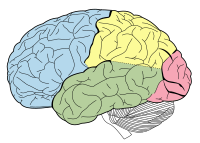
Photo from wikipedia
&NA; The hippocampus and dorsal striatum are important structures involved in place and response learning strategies respectively. Both sex and estrous cycle phase differences in learning strategy preference exist following… Click to show full abstract
&NA; The hippocampus and dorsal striatum are important structures involved in place and response learning strategies respectively. Both sex and estrous cycle phase differences in learning strategy preference exist following cue competition paradigms. Furthermore, significant effects of sex and learning strategy on hippocampal neural plasticity have been reported. However, associations between learning strategy and immediate early gene (IEG) expression in the hippocampus and dorsal striatum are not completely understood. In the current study we investigated the effects of sex and estrous cycle phase on strategy choice and IEG expression in the hippocampus and dorsal striatum of rats following cue competition training in the Morris water maze. We found that proestrous rats were more likely to choose a place strategy than non‐proestrous or male rats. Although male cue strategy users travelled greater distances than the other groups on the first day of training, there were no other sex or strategy differences in the ability to reach a hidden or a visible platform. Female place strategy users exhibited greater zif268 expression and male place strategy users exhibited greater cFos expression compared to all other groups in CA3. Furthermore, cue strategy users had greater expression of cFos in the dorsal striatum than place strategy users. Shorter distances to reach a visible platform were associated with less activation of cFos in CA3 and CA1 of male place strategy users. Our findings indicate multiple differences in brain activation with sex and strategy use, despite limited behavioral differences between the sexes on this cue competition paradigm. HighlightsProestrous rats prefer a place strategy.Non‐proestrous rats or male rats prefer a cue strategy.The proestrous stage is associated with greater cFos expression in the dentate gyrus.Female place strategy users exhibit greater zif268 expression in cornus ammonis (CA) 3.Better performance is associated with less cFos activation in CA3 and CA1.
Journal Title: Hormones and Behavior
Year Published: 2017
Link to full text (if available)
Share on Social Media: Sign Up to like & get
recommendations!